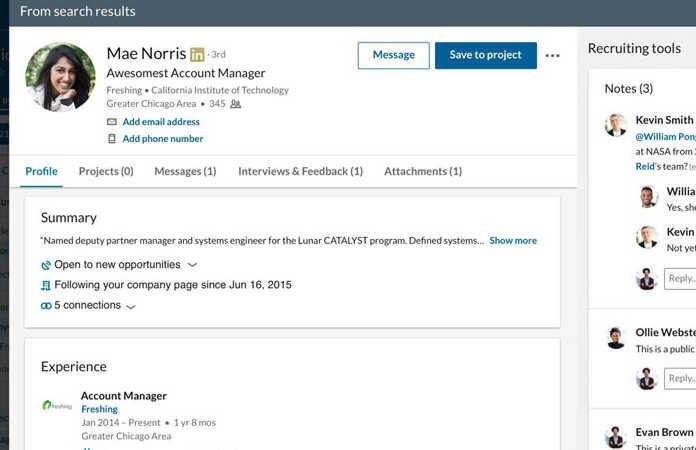
LinkedIn said it will move LinkedIn Recruiter, LinkedIn Jobs and Pipeline Builder to a single platform to create what it calls, “the new intelligent hiring experience.” The idea is to simplify the recruiter’s toolkit by putting the products into one place and providing access through a single, revamped interface.
Separately, the company also revealed that a new live-video feature is moving into a public beta phase. While the two announcements seem to be unrelated, we can never help thinking that nothing at LinkedIn is really unrelated.
2 @LinkedIn product announcements seem unrelated. But is anything LinkedIn does unrelated? #HR #HRTech #HRTribe Share on XThe unified recruiting service will launch during the summer of 2019. With it, “recruiters will be able to see all their candidates — whether they’re coming from Recruiter, Jobs or Pipeline Builder — in one unified pipeline,” wrote Vice President of Product John Jersin in a blog post.
More interesting, however, is Jersin’s statement that, “our products will be able to learn from each other, getting smarter with every click and giving you proactive recommendations.” The system will track which candidates users save or hide, as well as who they contact through InMail. Machine learning will make the tools “[get] smarter with every click you make.”
In the coming months, LinkedIn plans to release 15 enhancements to LinkedIn Recruiter and LinkedIn Jobs. They’re designed to improve collaboration, increase productivity and, in general, improve search outcomes. Among the new features:
- A single pipeline that allows users to manager candidates in one place, without jumping from tool to tool.
- The ability to review candidate profiles directly from search results, without losing your place.
- Candidate recommendations based on the tools’ ability to share information and follow the user’s search and communications activities.
- A shared messages feature that displays all communications between the recruiting team and a candidate in one place.
- The ability to easily send rejection messages individually or in bulk.
Now Add Video…
Separately, LinkedIn announced a live-video feature, called LinkedIn Live, will be available on its regular platform, although initially only invited beta users will have access to it. At the outset only videos from third-party streaming services will be offered, and it’s not clear when individual users will be able to product their own programs.
The first video services include Wirecast, Switcher Studio and Wowza Media, TechCrunch reported. More will be added soon. They’ll stream events such as conferences, product announcements, Q&As and earnings calls.
Microsoft’s Azure Media Services is handling the encoding, making this one of the products parent and child have developed together. As TechCrunch noted, Microsoft “has mostly kept a distance in terms of knitting together product development between the two” since it acquired the social network in 2016.
With LinkedIn Live, viewers will be able to ask questions or comment on videos in real time. Hosts will be able to moderate those comments as they’re posted.
Peter Roybal, head of video product management, told TechCrunch that monetization will “come down the road, but for right now we are focused on awesome use cases.” He also observed, “This could even be a way to try out some new ideas.”
Why Video Matters
In Microsoft’s 2018 annual report, CEO Satya Nadella called it, “the essential platform to connect the world’s professionals and create economic opportunity for every member of the global workforce.” He also took note of efforts to use Redmond’s technology on the way to enhancing LinkedIn’s usefulness as a talent acquisition tool.
While LinkedIn offers paid services for sales and marketing as well as recruiting, Microsoft said its revenue came primarily from Talent Solutions. (Also, SHRM says 94 percent of employers who use social networks to recruit use LinkedIn.) If you consider how Facebook and Twitter have jumped into video, it’s no surprise that LinkedIn is becoming more aggressive in the area.
When we combine that with the increasing use of video interview tools—including Skype’s whiteboard interview features—as well as LinkedIn’s continuing investment in strengthened recruiter tools, we can’t help but think somewhere in Sunnyvale discussions are going on about incorporating video features into the talent acquisition suite.
There’s a flip side here, however. After studying 3,000 LinkedIn posts, Sumo’s Noah Kagan concluded that incorporating multimedia assets (i.e., video) leads to lower traffic. That could change as LinkedIn’s user base inevitably grows younger.
Whether it’s by design or not, LinkedIn’s had a good week in terms of product development for both the short and long terms. Its unification, for lack of a better word, of Recruiter, Jobs and Pipeline builder is sure to make recruiters happy. At the same time, wading deeper into video prepares it for the time when multimedia becomes a more influential piece of the recruiting process.
Sign up for our newsletter here.
Image: LinkedIn













